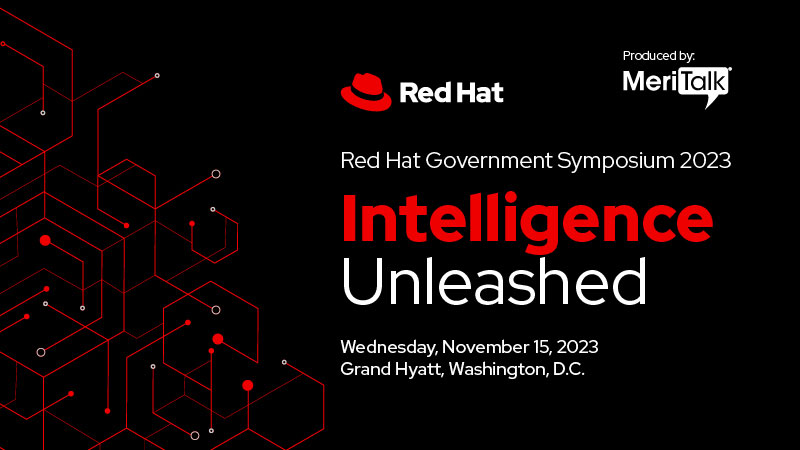
Automation is a vital piece of the digital transformation that is sweeping across Federal agencies. It improves workflows and speeds processes, ultimately improving the quality of citizen services. MeriTalk recently sat down with Adam Clater, chief architect for North America Public Sector at Red Hat, to discuss the power of automation to transform citizen services, how agencies can plan for automation across the enterprise, and the importance of automating on a secure, stable foundation.
MeriTalk: Let’s talk broadly about automation in the Federal space. How far along are agencies in the use of automation to support digital transformation for improved citizen services?
Clater: Everyone is looking at how they can use more automation to move their mission forward. I think it’s important to understand why we should automate. It’s not simply to do things faster. It’s also because humans are very, very good at being innovative and doing an interesting thing one time, but when we do that thing three, four, five, or six times, we tend to make mistakes. A lot of outages and errors that we see in IT derive from human errors, for example. With automation, we can make sure that the quality of service we’re delivering stays very, very high.
Agencies that Red Hat has worked with closely, especially around our Ansible automation platform, have massively improved their automation capabilities. Ansible helps agencies spin up entire capabilities in a cloud provider in a matter of minutes or hours, depending on the size of the infrastructure. The ability to bring workloads into production quickly has really had an impact, especially in agencies that are delivering citizen services.
MeriTalk: What are some of the obstacles that agencies face in trying to automate more?
Clater: Lack of integration across automation platforms is a primary obstacle. For example, an agency may buy networking equipment from one vendor, storage from another vendor, and compute hardware from a third. These vendors have their own automation languages and may not integrate well with each other. What if I need to create a network, deploy a server, and create storage? Automating all of that can be difficult if you’re using multiple platforms. Ansible does a great job of bridging those silos – it’s a Swiss Army knife of automation.
MeriTalk: How should agencies plan for automation across the enterprise?
Clater: The first thing to recognize is that there is likely someone doing some automation in your organization today, probably several people. But they may only be truly knowledgeable about their own sphere of influence. You may have a network person automating network infrastructure who is not comfortable with systems automation. When you look at adopting an automation platform across an enterprise, you need to work with the technical folks in each technology silo to get them up to speed, and you have to answer this question: Why do they want to adopt this technology? You have to be able to talk to them about the opportunities that this is going to open up for them to do more and better things.
MeriTalk: How could automation across workflows redefine service delivery for agencies?
Clater: Let’s take the Federal Emergency Management Agency (FEMA). When Hurricane Maria hit Puerto Rico, the basic infrastructure was wiped out. FEMA had to build entire components of technology infrastructure from the ground up – a cellular network, a Wi-Fi network, and basic communication between components. That would have been impossible to do without automation. Whether we find ourselves in a natural disaster, a battlefield, or a place with little connectivity, automation becomes crucial to deploying the required communications infrastructure.
MeriTalk: Let’s talk a little about generative artificial intelligence (AI). Can Federal agencies leverage generative AI as part of a broader automation strategy to improve customer experience?
Clater: Yes, agencies are quickly building chatbots and other generative AI technologies that enhance experience. The Department of Energy has a helpful chatbot, and if, say, I put a chatbot on irs.gov to help people figure out how to file their taxes, that’s a good use of generative AI. Those use cases work because the AI can be trained on a specific publicly available data set. At this point, large language models are really good at writing about things that are publicly available. But if I ask for help looking at a corpus of data and determining whether it indicates fraud, for example, the model would have little insight. Extensive training of large language models needs to be done to answer hard questions – like whether a specific activity is fraudulent. That’s where generative AI is not yet useful to government – but it has huge potential.
MeriTalk: How does Red Hat help Federal IT leaders and their teams automate efficiently and do more with less?
Clater: Red Hat has been building automation into everything it does for the past quarter century. We see that automation naturally in the data center, where Red Hat started, and we extend that into the cloud. We talked about how technological silos can create obstacles to automation. That’s what’s great about Ansible – it’s designed from the ground up to bridge those silos. It not only talks to other automation platforms, but it can also build complex workflows so you can deploy a network, servers, storage, and operating systems, configure a firewall, and talk to your virtualization platform – all within a single automation workflow.
MeriTalk: Red Hat is known for enabling automation on a stable and secure foundation. How does Red Hat Enterprise Linux (RHEL) help agencies automate across the enterprise?
Clater: Red Hat Enterprise Linux has a strong legacy when it comes to security. It has been through Common Criteria EAL 4+ certification more than any other operating system in the world. We are also very proud that the STIG (Security Technical Implementation Guide) for Red Hat Enterprise Linux 9 was just released. It’s a guide for implementing RHEL in a secure operating environment. We distribute the code to implement security controls as an Ansible workbook, so agencies can automatically apply those controls and – perhaps more importantly – automatically determine whether the controls have been implemented and whether they have been modified. This is incredibly valuable. As agencies look to balance the scales of rapid innovation, secure deployment, and stable environments, an operating system like Linux becomes a great foundation.
MeriTalk: The Red Hat Government Symposium is coming up on November 15. Can you give us a preview of the discussions about AI and automation?

Clater: We’ll hear from some really interesting and innovative folks at the symposium, including Ben Cushing, one of my peers at Red Hat. Ben works with the Department of Veterans Affairs on many programs, including one that I find especially compelling – it uses artificial intelligence to identify veterans who are at risk of suicide. Definitely make time for Ben’s panel discussion about realizing the promise of AI with end-to-end data science. He’ll be talking with Jose Arrieta, former CIO of the Department of Health and Human Services, Lauren Boas Hayes, senior advisor for technology and innovation at the Cybersecurity and Infrastructure Security Agency, and Damian Kostiuk, deputy chief data officer at U.S. Citizenship and Immigration Services.
